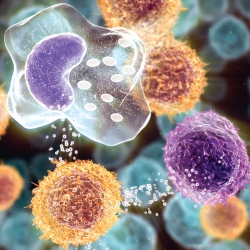
The nanorods, which are about the size of a small virus, can harvest and convert otherwise harmless light into heat. But because each nanorod radiates miniscule heat, many are needed to kill a cell.
"Ideally, you’d like to use a low-power laser to minimize the risks to healthy tissue, and the more particles you can load inside the cell, the lower you can set the power level and irradiation time," said Zubarev, an investigator at Rice’s BioScience Research Collaborative (BRC).
Unfortunately, scientists who study gold nanorods have found it difficult to load large numbers of particles into living cells. For starters, nanorods are pure gold, which means they won’t dissolve in solution unless they are combined with some kind of polymer or surfactant. The most commonly used of these is cetyltrimethylammonium bromide, or CTAB, a soapy chemical often used in hair conditioner.
CTAB is a key ingredient in the production of nanorods, so scientists have often relied upon it to make nanorods soluble in water. CTAB does this job by coating the surface of the nanorods in much the same way that soap envelopes and dissolves droplets of grease in dishwater. CTAB-encased nanorods also have a positive charge on their surfaces, which encourages cells to ingest them. Unfortunately, CTAB is also toxic, which makes it problematic for biomedical applications.
In the new research, Zubarev, Rice graduate student Leonid Vigderman and former graduate student Pramit Manna, now at Applied Materials Inc., describe a method to completely replace CTAB with a closely related molecule called MTAB that has two additional atoms attached at one end.
The additional atoms — one sulfur and one hydrogen — allow MTAB to form a permanent chemical bond with gold nanorods. In contrast, CTAB binds more weakly to nanorods and has a tendency to leak into surrounding media from time to time, which is believed to be the underlying cause of CTAB-encased nanorod toxicity.
It took Zubarev, Vigderman and Manna several years to identify the optimal strategy to synthesize MTAB and substitute it for
